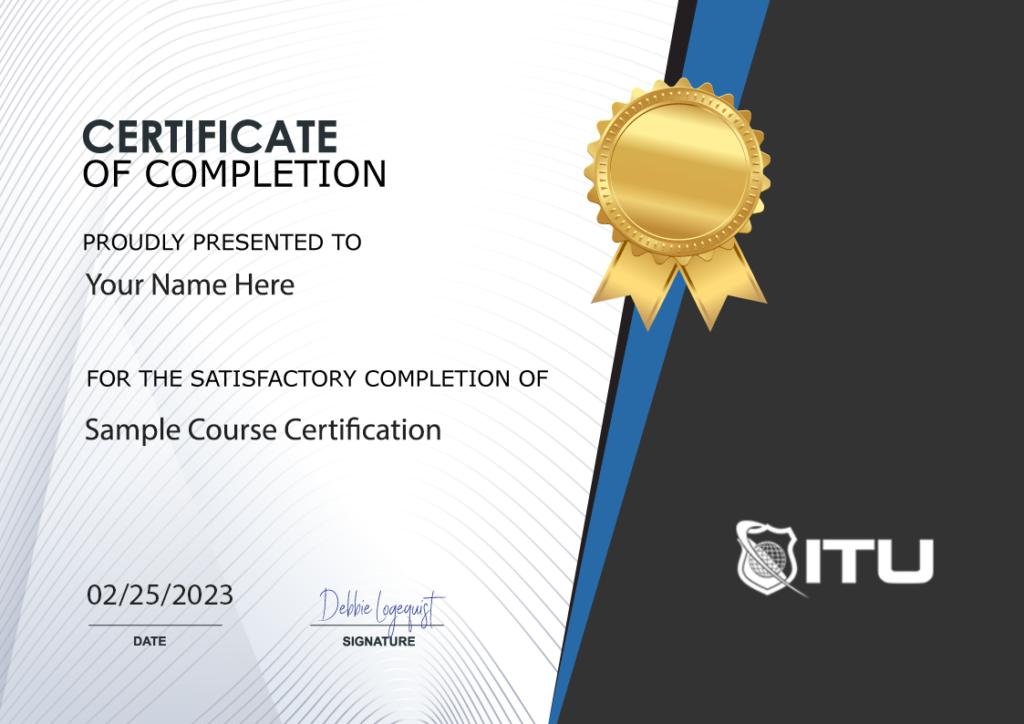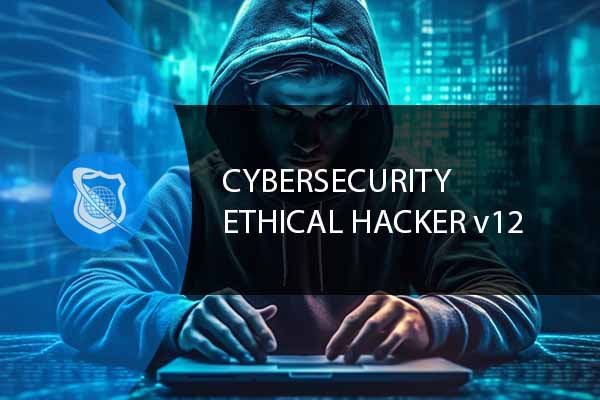Certified Ethical Hacker (CEH) V12: Your Pathway to CEH Training For Certification
Certified Ethical Hacker v12 is the latest iteration of EC-Council’s Certified Ethical Hacker v12 series. ITU offers CEH training to provide you the tools to research, discover and scan targets, analyze vulnerabilities and test attack methods and tools. The focus of this CEH online training course is to solve the challenge of breaking into a target network, collect evidence of success, and escape unnoticed. Every lesson and topic are infused with step-by-step guided practice using real hardware- and software-based hacking tools. Throughout both lecture and hands-on activities, the instructor, Chrys Thorsen provides commentary from the field including tips, tricks and hard-learned lessons.
Included In This Course



Closed Captions



Certificate of Completion
Course Description for Certified Ethical Hacker (CEH) v12
The Certified Ethical Hacker (CEH) v12 course provides an in-depth understanding of ethical hacking phases, attack vectors, and preventive countermeasures. This course is designed to equip learners with the skills necessary to identify vulnerabilities in systems and secure them effectively. Covering a wide range of topics from footprinting and reconnaissance to malware threats and hacking mobile platforms, this course ensures comprehensive knowledge in ethical hacking.
Learners will engage with various real-world scenarios and hands-on activities such as OSINT tools, Nmap scanning, and vulnerability analysis. By the end of this course, participants will have a solid foundation in ethical hacking principles, techniques, and tools, preparing them for the CEH certification exam and a career in cybersecurity.
What You Will Learn in Certified Ethical Hacker (CEH) v12
In this course, you will gain the following skills and knowledge:
- Introduction to the key concepts of ethical hacking and information security.
- Conducting footprinting and reconnaissance using advanced tools and techniques.
- Scanning networks and identifying vulnerabilities.
- Performing system hacking and exploiting operating systems.
- Understanding malware threats and implementing countermeasures.
- Utilizing social engineering techniques and tools.
- Executing Denial-of-Service (DoS) and session hijacking attacks.
- Evading IDS, firewalls, and honeypots.
- Hacking web servers and applications.
- Performing SQL injection and securing databases.
- Hacking wireless networks and mobile platforms.
- Exploring IoT and OT hacking methodologies.
- Securing cloud environments and implementing cryptographic techniques.
Exam Objectives for Certified Ethical Hacker (CEH) v12 Certification
The Certified Ethical Hacker (CEH) v12 certification, governed by EC-Council, evaluates your skills in the following areas:
- Information Security and Ethical Hacking Introduction
- Footprinting and Reconnaissance: 15%
- Scanning Networks: 13%
- Enumeration: 14%
- Vulnerability Analysis: 12%
- System Hacking: 13%
- Malware Threats: 10%
- Sniffing: 10%
- Social Engineering: 9%
- Denial-of-Service: 9%
- Session Hijacking: 9%
- Evading IDS, Firewalls, and Honeypots: 10%
- Hacking Web Servers and Applications: 13%
- SQL Injection: 12%
- Hacking Wireless Networks: 10%
- Hacking Mobile Platforms: 10%
- IoT and OT Hacking: 10%
- Cloud Computing: 9%
- Cryptography: 12%
Who This Certified Ethical Hacker (CEH) v12 Course is For
This course is designed for:
- IT professionals looking to advance their career in cybersecurity.
- Security officers, auditors, and site administrators.
- Network infrastructure professionals and penetration testers.
- Individuals aiming to achieve the CEH certification.
- Anyone interested in learning ethical hacking from a practical perspective.
The CEH v12 course is accessible for beginners who are keen on entering the cybersecurity field, as well as experienced professionals seeking to deepen their knowledge and skills.
Possible Jobs You Can Get With This Knowledge from Certified Ethical Hacker (CEH) v12
With the skills acquired from the CEH v12 course, you can pursue various roles such as:
- Ethical Hacker
- Penetration Tester
- Information Security Analyst
- Cybersecurity Consultant
- Network Security Engineer
- IT Security Administrator
- Security Auditor
These roles span across multiple industries, providing a robust career path in the ever-growing field of cybersecurity.
Average Industry Salaries for People with Certified Ethical Hacker (CEH) v12 Skills
Professionals with CEH v12 skills can expect competitive salaries, such as:
- Ethical Hacker: $80,000 – $120,000 per year
- Penetration Tester: $70,000 – $110,000 per year
- Information Security Analyst: $75,000 – $115,000 per year
- Cybersecurity Consultant: $85,000 – $130,000 per year
- Network Security Engineer: $90,000 – $125,000 per year
These figures provide an estimate of the financial benefits and potential earnings in the cybersecurity industry.
Get Started Today with Certified Ethical Hacker (CEH) v12
Enroll in the Certified Ethical Hacker (CEH) v12 course today and take the first step towards becoming a skilled cybersecurity professional. This comprehensive course provides practical knowledge and hands-on experience, preparing you for the CEH certification and a successful career in ethical hacking. Don’t wait—start your journey to becoming an ethical hacker now and secure your place in the rapidly evolving cybersecurity landscape.
Key Term Knowledge Base: Key Terms Related to Certified Ethical Hacker (CEH) V12
Understanding the key terms related to Certified Ethical Hacker (CEH) V12 is crucial for anyone aspiring to enter the field of ethical hacking and cybersecurity. These terms form the foundation of knowledge required to navigate this complex and evolving domain. They are not only vital for passing the CEH certification exam but also for practical application in the cybersecurity industry.
| Term | Definition |
|---|---|
| Ethical Hacking | The practice of legally breaking into computers and devices to test an organization’s defenses. |
| Cybersecurity | The practice of protecting systems, networks, and programs from digital attacks. |
| Cryptography | The art of writing or solving codes; a critical aspect of securing communication and data. |
| Footprinting | The technique of gathering information about computer systems and the entities they belong to. |
| Reconnaissance | The practice of collecting information about an adversary in the preparation phase of a cyber-attack. |
| Scanning Networks | The process of identifying active devices on a network and their vulnerabilities. |
| Enumeration | The process of extracting user names, machine names, network resources, shares, and services from a system. |
| Social Engineering | The art of manipulating people to give up confidential information. |
| Phishing | A cybercrime in which a target is contacted by email, telephone, or text message by someone posing as a legitimate institution to lure individuals into providing sensitive data. |
| Malware | Software designed to disrupt, damage, or gain unauthorized access to a computer system. |
| Penetration Testing | The practice of testing a computer system, network, or web application to find vulnerabilities that an attacker could exploit. |
| Vulnerability | A weakness in a system that can be exploited by a cyber-attack. |
| Exploit | A piece of software, chunk of data, or sequence of commands that takes advantage of a bug or vulnerability to cause unintended or unanticipated behavior to occur on computer software, hardware, or something electronic. |
| SQL Injection | A code injection technique used to attack data-driven applications by inserting malicious SQL statements into an entry field. |
| Cross-Site Scripting (XSS) | A type of security vulnerability typically found in web applications that enables attackers to inject client-side scripts into web pages viewed by other users. |
| Intrusion Detection System (IDS) | A device or software application that monitors a network or systems for malicious activity or policy violations. |
| Firewall | A network security device that monitors and filters incoming and outgoing network traffic based on an organization’s previously established security policies. |
| Honeypot | A security mechanism set to detect, deflect, or study attempts at unauthorized use of information systems. |
| Risk Management | The forecasting and evaluation of financial risks together with the identification of procedures to avoid or minimize their impact. |
| Incident Management | A term describing the activities of an organization to identify, analyze, and correct hazards to prevent a future reoccurrence. |
These terms are essential for grasping the fundamental concepts in ethical hacking and cybersecurity. Mastery of these terms not only aids in CEH certification but also enhances practical skills in cybersecurity defense and attack strategies.
Frequently Asked Questions Related to CEH Training
Is Certified Ethical Hacker Certification worth it?
Does it really work? Short answers to these questions are clear: ‘Yes. Certified Ethics Hackers are an excellent investment that will only help you gain valuable skills. CEH provides an important qualification for your future career in addition to technical knowledge.
How do I become CEH certified?
To become CEH a certified ethical one, you can follow these steps:
1. Take the Certified Ethical Hacker (CEH) course certification, which typically involves five days of training
2. Learn about the latest cybersecurity and information security threats, and develop the practical hacking skills needed to work as an a certified ethical hacker
3. Pass the CEH exam which consists of a total of 125 multiple-choice questions
4. Maintain your certification by earning 120 Continuing Professional Education (CPE) credits within three years
5. You can earn CPE credits by attending conferences, writing research papers, teaching training classes in a related domain, reading materials on related subject matters, and attending webinars
How long does it take to become a Certified Ethical Hacker?
The Certified Ethical Hacker (CEH) certification exam, is a 4-hour exam with 125 multiple-choice questions. To become a Certified Ethical Hacker, prepare for the exam by taking our comprehensive CEH training and then complete the certification exam. The length of time it takes to prepare for the ceh certification training and exam can vary depending on your existing knowledge and experience, but it could take anywhere from a week to several months. To take the CEH certification exam, you need to fulfill one of two prerequisites and be over 18 years old
How much does the CEH certification cost?
The cost of the Certified Ethical Hacker (CEH) certification varies depending on the type of training you choose. You can get started with the ITU Online course for Certified Ethical Hacker Certification Training – The InfoSec Institute estimates that the average salary for CEH holders is $83,591, with most holders earning between $45K and $129K per year.
How long is the CEH certification valid, and how can I maintain it?
The CEH certification is valid for three years from the date of certification. To maintain your certification, you are required to earn Continuing Professional Education (CPE) credits. These credits can be obtained through various activities such as attending training programs, participating in webinars, writing articles, and engaging in professional development activities related to ethical hacking and information security. By earning a sufficient number of CPE credits within the three-year period, you can renew your CEH certification.
Blogs of Interest Related to This Course
- CEH Certification Requirements: An Essential Checklist for Future Ethical Hackers
- Enhance Your IT Expertise: CEH Certified Ethical Hacker All-in-One Exam Guide Explained
- Convert PDF to Flipbook Adobe InDesign: A How to Step-by-Step Tutorial
- Security Analyst: The Guardian of Cybersecurity in the Modern Business Landscape
- Certified Ethical Hacker vs. Penetration Tester : What's the Difference?
- CEH Exam Questions : Top 10 Tips for Success
- Free online training certificates : A Look at the Most Sought-after Free Tech Certifications Online
- A Guide to Mobile Device Security
- Kali Linux : The Complete Ethical Hacker's Toolbox
- The Best AI Uses For Businesses
Proudly DisplayYour Achievement
Upon completion of your training, you’ll receive a personalized certificate of completion to help validate to others your new skills.
Certified Ethical Hacker (CEH) v12 Course Content
Module 1 - Introduction To Ethical Hacking
- 1.0 Introduction to CEH v12
- 1.1 Elements of Security
- 1.2 Cyber Kill Chain
- 1.3 MITRE ATT&CK Framework
- 1.3.1 Activity - Researching the MITRE ATTACK Framework
- 1.4 Hacking
- 1.5 Ethical Hacking
- 1.6 Information Assurance
- 1.7 Risk Management
- 1.8 Incident Management
- 1.9 Information Security Laws and Standards
- 1.10 Introduction to Ethical Hacking Review
Module 2: Footprinting and Reconnaissance
- 2.1 Footprinting Concepts
- 2.2 OSINT Tools
- 2.2.1 Activity - Conduct OSINT with OSR Framework
- 2.2.2 Activity - OSINT with theHarvester
- 2.2.3 Activity - Add API Keys to theHarvester
- 2.2.4 Activity - Extract Document Metadata with FOCA
- 2.2.5 Activity - Extract Document Metadata with FOCA
- 2.3 Advanced Google Search
- 2.3.1 Activity - Google Hacking
- 2.4 Whois Footprinting
- 2.4.1 Activity - Conducting Whois Research
- 2.5 DNS Footprinting
- 2.5.1 Activity - Query DNS with NSLOOKUP
- 2.6 Website Footprinting
- 2.6.1 Activity - Fingerprint a Webserver with ID Serve
- 2.6.2 Activity - Extract Data from Websites
- 2.6.3 Activity - Mirror a Website with HTTrack
- 2.7 Email Footprinting
- 2.7.1 Activity - Trace a Suspicious Email
- 2.8 Network Footprinting
- 2.9 Social Network Footprinting
- 2.10 Footprinting and Reconnaissance Countermeasures
- 2.11 Footprinting and Reconnaissance Review
Module 3: Scanning Networks
- 3.1 Scanning Concepts
- 3.2 Discovery Scans
- 3.2.1 Activity - ICMP ECHO and ARP Pings
- 3.2.2 Activity - Host Discovery with Angry IP Scanner
- 3.3 Port Scans
- 3.3.1 Activity - Port Scan with Angry IP Scanner
- 3.4 Other Scan Types
- 3.5 Scanning Tools
- 3.5.1 Activity - Hping3 Packet Crafting
- 3.5.2 Activity - Fingerprinting with Zenmap
- 3.6 NMAP
- 3.6.1 Activity - Nmap Basic Scans
- 3.6.2 Activity - Host Discovery with Nmap
- 3.6.3 - Activity - Nmap Version Detection
- 3.6.4 Activity - Nmap Idle (Zombie) Scan
- 3.6.5 Activity - Nmap FTP Bounce Scan
- 3.6.6 - Activity - NMAP Scripts
- 3.7 Firewall and IDS Evasion
- 3.7.1 Activity - Nmap Advanced Scans
- 3.8 Proxies
- 3.9 Scanning Countermeasures
- 3.10 Scanning Networks Review
Module 4: Enumeration
- 4.1 Enumeration Overview
- 4.2 SMB_NetBIOS_Enumeration
- 4.2.1 Activity - Enumerate NetBIOS Information with Hyena
- 4.3 File Transfer Enumeration
- 4.4 WMI Enumeration
- 4.4.1 - Activity - Enumerating WMI with Hyena
- 4.5 SNMP Enumeration
- 4.5.1 Activity - Enumerate WMI, SNMP and Other Information Using SoftPerfect
- 4.6 LDAP Enumeration
- 4.7 DNS Enumeration
- 4.8 SMTP Enumeration
- 4.8.1 Activity - Enumerate Email Users with SMTP
- 4.9 Remote Connection Enumeration
- 4.10 Website Enumeration
- 4.10.1 Activity - Enumerate a Website with DirBuster
- 4.11 Other Enumeration Types
- 4.12 Enumeration Countermeasures and Review
Module 5: Vulnerability Analysis
- 5.1 Vulnerability Scanning
- 5.1.1 Vulnerability Scanning with OpenVAS
- 5.2 Vulnerability Assessment
- 5.3 Vulnerability Analysis Review
Module 6: System Hacking
- 6.1 System Hacking Concepts
- 6.2 Common OS Exploits
- 6.3 Buffer Overflows
- 6.3.1 Activity - Performing a Buffer Overflow
- 6.4 System Hacking Tools and Frameworks
- 6.4.1 Activity - Hack a Linux Target from Start to Finish
- 6.5 Metasploit
- 6.5.1 Activity - Get Started with Metasploit
- 6.6 Meterpreter
- 6.7 Keylogging and Spyware
- 6.7.1 Activity - Keylogging with Meterpreter
- 6.8 Netcat
- 6.8.1 Activity - Using Netcat
- 6.9 Hacking Windows
- 6.9.1 Activity - Hacking Windows with Eternal Blue
- 6.10 Hacking Linux
- 6.11 Password Attacks
- 6.11.1 Activity - Pass the Hash
- 6.11.2 Activity - Password Spraying
- 6.12 Password Cracking Tools
- 6.13 Windows Password Cracking
- 6.13.1 Activity - Cracking Windows Passwords
- 6.13.2 Activity - Cracking Password Hashes with Hashcat
- 6.14 Linux Password Cracking
- 6.15 Other Methods for Obtaining Passwords
- 6.16 Network Service Attacks
- 6.16.1 Activity - Brute Forcing a Network Service with Medusa
- 6.17 Post Exploitation
- 6.18 Pivoting
- 6.18.1 & 6.18.2 Activity - Pivoting Setup and Attack
- 6.19 Maintaining Access
- 6.19.1 Activity - Persistence
- 6.20 Hiding Data
- 6.20.1 Activity - Hiding Data Using Least Significant Bit Steganography
- 6.21 Covering Tracks
- 6.21.1 Activity - Clearing Tracks in Windows
- 6.21.2 Activity - View and Clear Audit Policies with Auditpol
- 6.22 System Hacking Countermeasures
- 6.23 System Hacking Review
Module 7: Malware Threats
- 7.1 Malware Overview
- 7.2 Viruses
- 7.3 Trojans
- 7.3.1 Activity - Deploying a RAT
- 7.4 Rootkits
- 7.5 Other Malware
- 7.6 Advanced Persistent Threat
- 7.7 Malware Makers
- 7.7.1 Activity - Creating a Malware Dropper and Handler
- 7.8 Malware Detection
- 7.9 Malware Analysis
- 7.9.1 Activity - Performing a Static Code Review
- 7.9.2 Activity - Analyzing the SolarWinds Orion Hack
- 7.10 Malware Countermeasures
- 7.11 Malware Threats Review
Module 8: Sniffing
- 8.1 Network Sniffing
- 8.2 Sniffing Tools
- 8.2.1 Activity- Sniffing HTTP with Wireshark
- 8.2.2 Activity - Capturing Files from SMB
- 8.3 ARP and MAC Attacks
- 8.3.1 Activity - Performing an MITM Attack with Ettercap
- 8.4 Name Resolution Attacks
- 8.4.1 Activity - Spoofing Responses with Responder
- 8.5 Other Layer 2 Attacks
- 8.6 Sniffing Countermeasures
- 8.7 Sniffing Review
Module 9: Social Engineering
- 9.1 Social Engineering Concepts
- 9.2 Social Engineering Techniques
- 9.2.1 Activity - Deploying a Baited USB Stick
- 9.2.2 Activity - Using an O.MG Lightning Cable
- 9.3 Social Engineering Tools
- 9.3.1 Activity - Phishing for Credentials
- 9.4 Social Media, Identity Theft, Insider Threats
- 9.5 Social Engineering Countermeasures
- 9.6 Social Engineering Review
Module 10: Denial-of-Service
- 10.1 DoS-DDoS Concepts
- 10.2 Volumetric Attacks
- 10.3 Fragmentation Attacks
- 10.4 State Exhaustion Attacks
- 10.5 Application Layer Attacks
- 10.5.1 Activity - Performing a LOIC Attack
- 10.5.2 Activity - Performing a HOIC Attack
- 10.5.3 Activity - Conducting a Slowloris Attack
- 10.6 Other Attacks
- 10.7 DoS Tools
- 10.8 DoS Countermeasures
- 10.9 DoS Review
Module 11: Session Hijacking
- 11.1 Session Hijacking
- 11.2 Compromising a Session Token
- 11.3 XSS
- 11.4 CSRF
- 11.5 Other Web Hijacking Attacks
- 11.6 Network-Level Session Hijacking
- 11.6.1 Activity - Hijack a Telnet Session
- 11.7 Session Hijacking Tools
- 11.8 Session Hijacking Countermeasures
- 11.9 Session Hijacking Review
Module 12: Evading IDS, Firewalls, and Honeypots
- 12.1 Types of IDS
- 12.2 Snort
- 12.3 System Logs
- 12.4 IDS Considerations
- 12.5 IDS Evasion
- 12.5.1 Activity - Fly Below IDS Radar
- 12.6 Firewalls
- 12.7 Packet Filtering Rules
- 12.8 Firewall Deployments
- 12.9 Split DNS
- 12.10 Firewall Product Types
- 12.11 Firewall Evasion
- 12.11.1 Activity - Use Social Engineering to Bypass a Windows Firewall
- 12.11.2 Activity - Busting the DOM for WAF Evasion
- 12.12 Honeypots
- 12.13 Honeypot Detection and Evasion
- 12.13.1 Activity - Test and Analyze a Honey Pot
- 12.14 Evading IDS, Firewalls, and Honeypots Review
Module 13: Hacking Web Servers
- 13.1 Web Server Operations
- 13.2 Hacking Web Servers
- 13.3 Common Web Server Attacks
- 13.3.1 Activity - Defacing a Website
- 13.4 Web Server Attack Tools
- 13.5 Hacking Web Servers Countermeasures
- 13.6 Hacking Web Servers Review
Module 14: Hacking Web Applications
- 14.1 Web Application Concepts
- 14.2 Attacking Web Apps
- 14.3 A01 Broken Access Control
- 14.4 A02 Cryptographic Failures
- 14.5 A03 Injection
- 14.5.1 Activity - Command Injection
- 14.6 A04 Insecure Design
- 14.7 A05 Security Misconfiguration
- 14.8 A06 Vulnerable and Outdated Components
- 14.9 A07 Identification and Authentication Failures
- 14.10 A08 Software and Data integrity Failures
- 14.11 A09 Security Logging and Monitoring Failures
- 14.12 A10 Server-Side Request Forgery
- 14.13 XSS Attacks
- 14.13.1 Activity - XSS Walkthrough
- 14.13.2 Activity - Inject a Malicious iFrame with XXS
- 14.14 CSRF
- 14.15 Parameter Tampering
- 14.15.1 Activity - Parameter Tampering with Burp
- 14.16 Clickjacking
- 14.17 SQL Injection
- 14.18 Insecure Deserialization Attacks
- 14.19 IDOR
- 14.19.1 Activity - Hacking with IDOR
- 14.20 Directory Traversal
- 14.21 Session Management Attacks
- 14.22 Response Splitting
- 14.23 Overflow Attacks
- 14.24 XXE Attacks
- 14.25 Web App DoS
- 14.26 Soap Attacks
- 14.27 AJAX Attacks
- 14.28 Web API Hacking
- 14.29 Webhooks and Web Shells
- 14.30 Web App Hacking Tools
- 14.31 Hacking Web Applications Countermeasures
- 14.32 Hacking Web Applications Review
Module 15: SQL Injection
- 15.1 SQL Injection Overview
- 15.2 Basic SQL Injection
- 15.3 Finding Vulnerable Websites
- 15.4 Error-based SQL Injection
- 15.5 Union SQL Injection
- 15.5.1 Activity - Testing SQLi on a Live Website - Part 1
- 15.5.2 Activity - Testing SQLi on a Live Website - Part 2
- 15.6 Blind SQL Injection
- 15.7 SQL Injection Tools
- 15.7.1 Activity - SQL Injection Using SQLmap
- 15.8 Evading Detection
- 15.9 Analyzing SQL Injection
- 15.10 SQL Injection Countermeasures
- 15.11 SQL Injection Review
Module 16: Hacking Wireless Networks
- 16.1 Wireless Concepts
- 16.2 Wireless Security Standards
- 16.3 WI-FI Discovery Tools
- 16.4 Common Wi-Fi Attacks
- 16.5 Wi-Fi Password Cracking
- 16.6 WEP Cracking
- 16.6.1 Activity - Cracking WEP
- 16.7 WPA,WPA2,WPA3 Cracking
- 16.7.1 Activity - WPA KRACK Attack
- 16.8 WPS Cracking
- 16.9 Bluetooth Hacking
- 16.10 Other Wireless Hacking
- 16.10.1 Activity - Cloning an RFID badge
- 16.10.2 Activity - Hacking with a Flipper Zero
- 16.11 Wireless Security Tools
- 16.12 Wireless Hacking Countermeasures
- 16.13 Hacking Wireless Networks Review
Module 17: Hacking Mobile Platforms
- 17.1 Mobile Device Overview
- 17.2 Mobile Device Attacks
- 17.3 Android Vulnerabilities
- 17.4 Rooting Android
- 17.5 Android Exploits
- 17.5.1 Activity - Hacking Android
- 17.5.2 Activity - Using a Mobile Device in a DDoS Campaign
- 17.6 Android-based Hacking Tools
- 17.7 Reverse Engineering an Android App
- 17.8 Securing Android
- 17.9 iOS Overview
- 17.10 Jailbreaking iOS
- 17.11 iOS Exploits
- 17.12 iOS-based Hacking Tools
- 17.13 Reverse Engineering an iOS App
- 17.14 Securing iOS
- 17.15 Mobile Device Management
- 17.16 Hacking Mobile Platforms Countermeasures
- 17.17 Hacking Mobile Platforms Review
Module 18: IoT AND OT Hacking
- 18.1 IoT Overview
- 18.2 IoT Infrastructure
- 18.3 IoT Vulnerabilities and Threats
- 18.3.1 Activity - Searching for Vulnerable IoT Devices
- 18.4 IoT Hacking Methodology and Tools
- 18.5 IoT Hacking Countermeasures
- 18.6 OT Concepts
- 18.7 IT-OT Convergence
- 18.8 OT Components
- 18.9 OT Vulnerabilities
- 18.10 OT Attack Methodology and Tools
- 18.11 OT Hacking Countermeasures
- 18.12 IoT and OT Hacking Review
Module 19: Cloud Computing
- 19.1 Cloud Computing Concepts
- 19.2 Cloud Types
- 19.3 Cloud Benefits and Considerations
- 19.4 Cloud Risks and Vulnerabilities
- 19.5 Cloud Threats and Countermeasures
- 19.5.1 Activity - Hacking S3 Buckets
- 19.6 Cloud Security Tools And Best Practices
- 19.7 Cloud Computing Review
Module 20: Cryptography
- 20.1 Cryptography Concepts
- 20.2 Symmetric Encryption
- 20.2.1 Activity - Symmetric Encryption
- 20.3 Asymmetric Encryption
- 20.3.1 Activity - Asymmetric Encryption
- 20.4 Public Key Exchange
- 20.5 PKI
- 20.5.1 Activity - Generating and Using an Asymmetric Key Pair
- 20.6 Digital Signatures
- 20.7 Hashing
- 20.7.1 Activity - Calculating Hashes
- 20.8 Common Cryptography Use Cases
- 20.9 Cryptography Tools
- 20.10 Cryptography Attacks
- 20.11 Cryptography Review
- 20.12 Course Conclusion
| 5 star | 82 | 82% |
| 4 star | 17 | 17% |
| 3 star | 1 | 1% |
| 2 star | 0% | |
| 1 star | 0% |
Sorry, no reviews match your current selections
Your Training Instructor
Chrys Thorsen is an education and technology expert who specializes in enterprise-level IT infrastructure consulting and certified training-of-trainers. In her career, she has garnered over 50 IT Certifications including CISSP, CISA, CEHv12, PenTest+, CompTIA CNVP, Cisco CCSI/CCNP, Microsoft Cloud and on-premises technologies, VMware vSphere, and many more. She has also authored 40 published certification textbooks, and over 35 full-length IT certification video courses.
When not working in the United States, Chrys spends her time abroad capacity-building IT literacy in developing nations in Sub-Saharan Africa. Her client list has included: the US Federal Government, the Republic of Zambia Ministry of Health, Cavendish University Zambia, Accenture, JP Morgan Chase, the US Centers for Disease Control and Prevention, the Elizabeth Glaser Pediatric AIDS Foundation (EGPAF), Hughes Aircraft, Microsoft, and many more.
Chrys lives by, and is fond of repeating, her professional creed:
“The only true measure of success for any project or training is results on the ground. Everything else is just noise.” “I teach what I deploy; I deploy what I teach.”

Subscribe To All-Access
Lock In $16.99 / Month Forever
Access this course and over 3,000 hours of focused IT training. Start your first month for only $1.00. Then lock in only $16.99 / month for life.
- Get Every Course
- Free Updates / New Content Added
- 3,000+ Hours of Training
- Price Lock Guarantee
- Games / Flashcards
- 21,000+ Practice Questions
$49.99 $16.99 Monthly
$49.00




good
Smooth delivery and easy access to LMS. Good to see that the LMS offers progress tracking. Would be great if badges were offered on completion of courses to share via Credly to future employers.